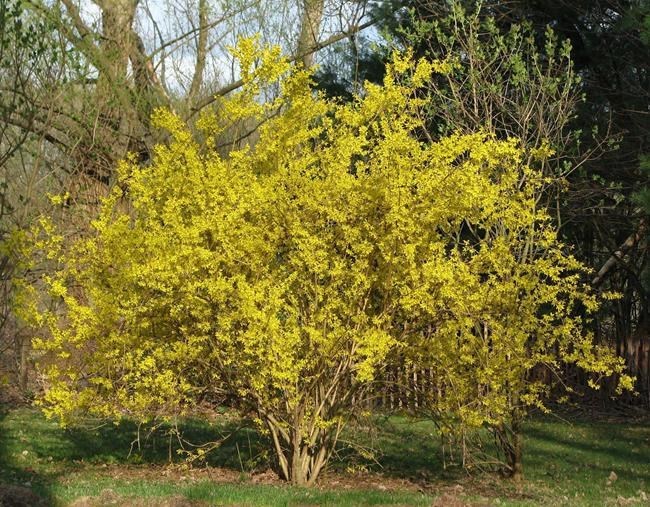
In this undated photo, a forsythia is shown in New Paltz, NY. This forsythia was in all its glory this spring because it was pruned well last spring. (Lee Reich via AP)
May 10, 2016 - 7:47 AM
The warm glow of forsythias cools down as their flowers fade and green leaves start to unfold. For the next 11 months, this plant that displays such cheerful colour on the drab heels of winter will be forgotten.
If you want the most from your forsythias next spring, however, don't turn your back on them right after their blossoms fade. Pruning soon after the last blossoms of spring hit the ground gets the shrubs ready for next year's show.
And don't wait too long, because forsythia is among those shrubs that make flower buds the year before they actually open into flowers. Delay pruning too long and those buds will not have time to mature enough, before the weather cools in autumn, to open into flowers next spring.
___
WHY PRUNE AT ALL?
Forsythia flowers most abundantly on stems that are just a few years old. One goal in pruning is to remove decrepit older stems that might cough forth a few blossoms but really are no longer capable of putting on a good show. Removing some of those old stems also lets more sunlight shine in on younger stems growing up from the base of the plant. Stems need to bask in sunlight if they're going to make good flower buds.
Like many other shrubs, forsythia sends up many new stems, called suckers, from the base of the plant. (That's what makes them shrubby.) It sends up so many, in fact, that they crowd and shade each other. Another goal of pruning, then, is to thin out enough of these young suckers so that those that remain can develop to their full potential.
___
GET INTIMATE WITH YOUR FORSYTHIA
For most of us, the tools for pruning a forsythia bush are not hedge shears, but a pair of hand shears and a lopper and, if pruning has been neglected for years, a small pruning saw.
Hedge shears shape forsythia bushes into globes and cubes, which is fine if that's the look you like in forsythia. Hand shears, a lopper and a saw create an arching fountain, which brings out forsythia's natural growth habit.
Crawl or reach into the base of your shrub to do your pruning. First, cut some of the oldest stems right to the ground or to vigorous, young branches originating near ground level.
Then grab your hand shears and cut some of the youngest stems — those suckers — also to the ground. Preferentially remove the most spindly young suckers, as well as those straying too far from the base of the plant.
Suckers might also be growing where the tips of older branches have arched to the ground and taken root. Yank their roots out and cut them free of older branches to prevent the bush from becoming an impenetrable, spreading tangle.
___
FOR MORE FORSYTHIA
Those rooted tips testify as to how easy it is to multiply forsythia. You could expand your planting by tucking those rooted tips into the ground wherever you want new shrubs. You could also deliberately bring a stem tip to the ground and anchor it with the weight of a brick or a stone; by autumn or spring, it should be rooted and ready for transplanting.
Forsythia also roots easily from cuttings — easily enough that you could just stick a few cuttings in the ground where you want a new shrub and then bank on at least one of them rooting. The best time to stick such cuttings was before growth began for the season, though.
Be careful, however: Too much forsythia could be too much of a good thing. Remember that once the blossoms fade, forsythia is nothing more than a mass of greenery. So save room for other plants also.
___
http://www.leereich.com/blog
http://leereich.com/
News from © The Associated Press, 2016